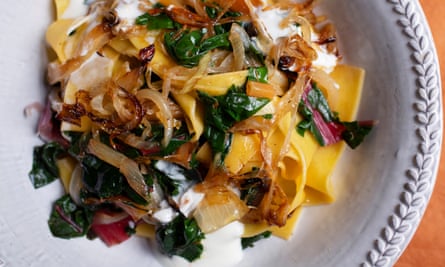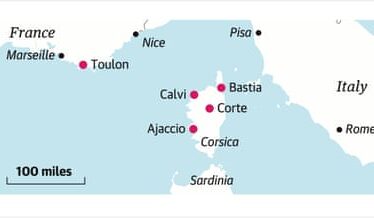
I have just spent a happy afternoon in the kitchen making a free-form pie, teasing the edges of the pastry loosely over the filling like a badly wrapped parcel and baking it without a dish or pie plate. I like this relaxed style of baking. Free from the constraints of a dish or tin, the pie is left to find its own shape on a baking sheet in the oven. It is a method that works with plums, apples, slices of pumpkin or potato – firm fillings that keep their shape rather than those that are soft and saucy.
This sort of pie is extremely good with onions you have cooked until deeply bronze and soft enough to crush between finger and thumb. Add ribbons of sauerkraut to balance their sweetness and you are in business. Layer them with a good grating of sharp cheese and a handful of chopped nuts and you have a pie to remember.
Leaf fall has also nudged me (happily) in the direction of pasta suppers. First off was a dish of wide ribbons of pappardelle tossed with buttered chard leaves, sweet onions and smoked paprika. A cracking recipe for a chilly autumn day.
Sauerkraut, fontina and walnut galette
By all means use a metal pie plate if you find it easier than baking the pie on a baking sheet. If you wish, you could make a vegetarian gravy for this, adding stock to browned onions and root vegetables, thyme and bay, and letting it simmer for an hour. Serves 8
For the pastry:
plain flour 250g
salt a large pinch
caraway seeds 1 tsp
butter 150g, cold
egg yolk 1, beaten
iced water 2 tbsp
For the filling:
onions 2, medium to large
olive oil 3 tbsp
sauerkraut 250g
fontina 225g, or other firm grating cheese
parsley leaves 10g
walnuts 100g
grain mustard 1 tbsp
egg 1, beaten
Make the pastry: put the flour in a large mixing bowl and add the salt and caraway seeds. Cut the butter into small pieces, add to the flour, then rub the two together with your thumbs and fingertips. (Alternatively use a food processor.) When you have a texture that resembles fresh breadcrumbs, stir in the beaten egg yolk and enough iced water (2-3 tbsp) to bring everything together into a soft, rollable dough. Wrap and leave in the fridge to rest for about 30 minutes.
Get on with making the filling: peel the onions and finely slice them into rings. Set the oven at 180C/gas mark 6.
Warm the oil in a deep pan set over a moderate heat, add the onions and let them cook until pale gold and soft. This will take a good 25 minutes, stirring regularly. Add the sauerkraut to the softened onions. Coarsely grate the cheese and set aside. Roughly chop the parsley and the walnuts, then stir into the softened onions with the mustard. Set aside while you form the tart.
Line a large baking sheet with baking parchment. Remove the pastry from the fridge and roll into a circle 30cm in diameter. Carefully lift on to the lined baking sheet. Stir the grated cheese, reserving some for later, into the onions and sauerkraut, then season with a little salt and black pepper. Pile the filling on to the pastry leaving a large gap, about 6-7cm, around the edge.
Fold the edge of the pastry up and slightly over the filling. Brush the pastry rim with beaten egg. Scatter the rest of the cheese over the top, place in the oven and bake for 50-60 minutes until golden.
Leave the tart to rest for 15 minutes or so before slicing and serving.
Pappardelle with greens and yoghurt
If you wanted to keep dairy out of this recipe, you could toss the pasta and greens with a little chilli oil instead. Serves 2-3
onions 2, medium to large
olive oil 3 tbsp
chard leaves 250g, or use beetroot tops
spinach 200g
pappardelle 200g
garlic 2 cloves
butter 50g
natural yoghurt 100ml
smoked paprika a little
Peel the onions and cut them into thin rings. Warm the oil in a flameproof casserole or a deep-sided frying pan over a moderate heat, add the onions and let them cook for about 20-25 minutes, stirring occasionally, until soft, shiny and deep gold in colour. Remove the onions from the pan and set aside.
Wash the chard leaves or beetroot tops, then return the onion pan to the heat (you can wipe it out if you wish, but you really don’t need to), then add the leaves, still wet from washing. Cover tightly and let them cook in their own steam for a minute or two, then turn the leaves over, cook for a minute longer, then remove and drain.
Repeat with the spinach. Gently squeeze the water from the chard and spinach, then roughly chop and add them to the onions.
Bring a deep pan of water to the boil. Salt it generously, then drop in the pappardelle and leave to cook for about 7 minutes or until the ribbons of pasta are tender.
Peel and thinly slice the garlic. Melt the butter in the empty pan in which you cooked the greens over a moderate heat, add the garlic and let it cook for a couple of minutes until it starts to turn golden, then add the chopped leaves.
Drain the pasta, leaving about 50ml of water in the pan, then toss it with the onions and greens.
Transfer the onions, greens and pasta to shallow bowls, then trickle with yoghurt and dust with a little smoked paprika.
Follow Nigel on Instagram @NigelSlater



